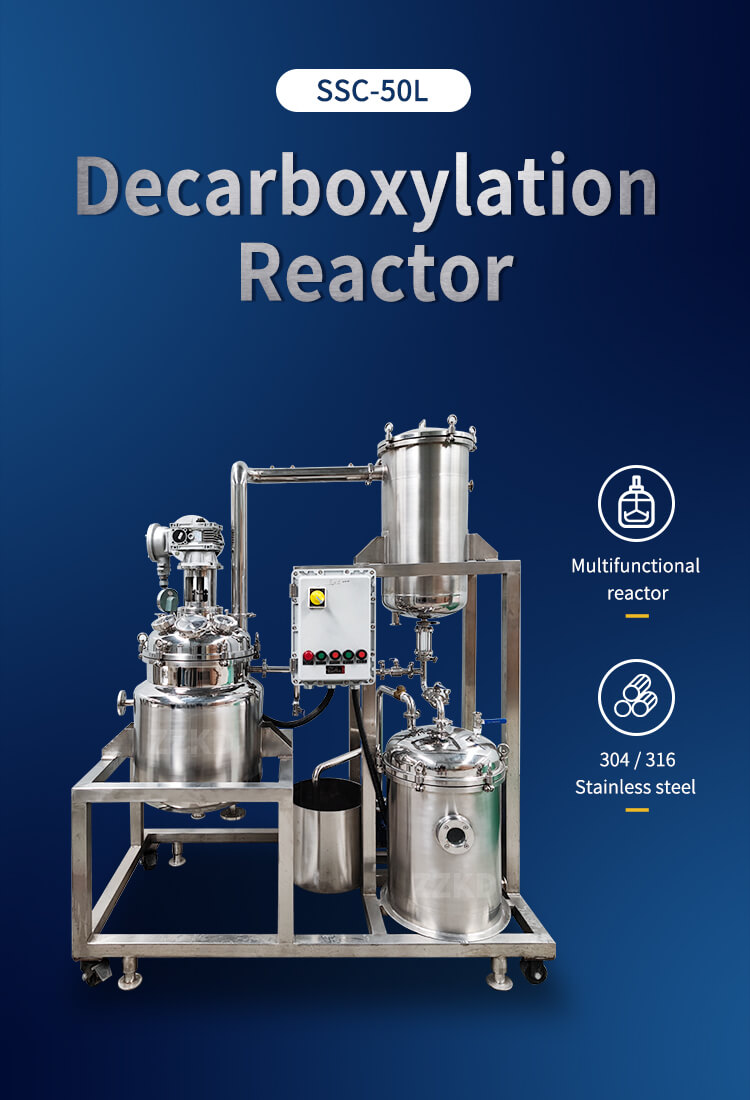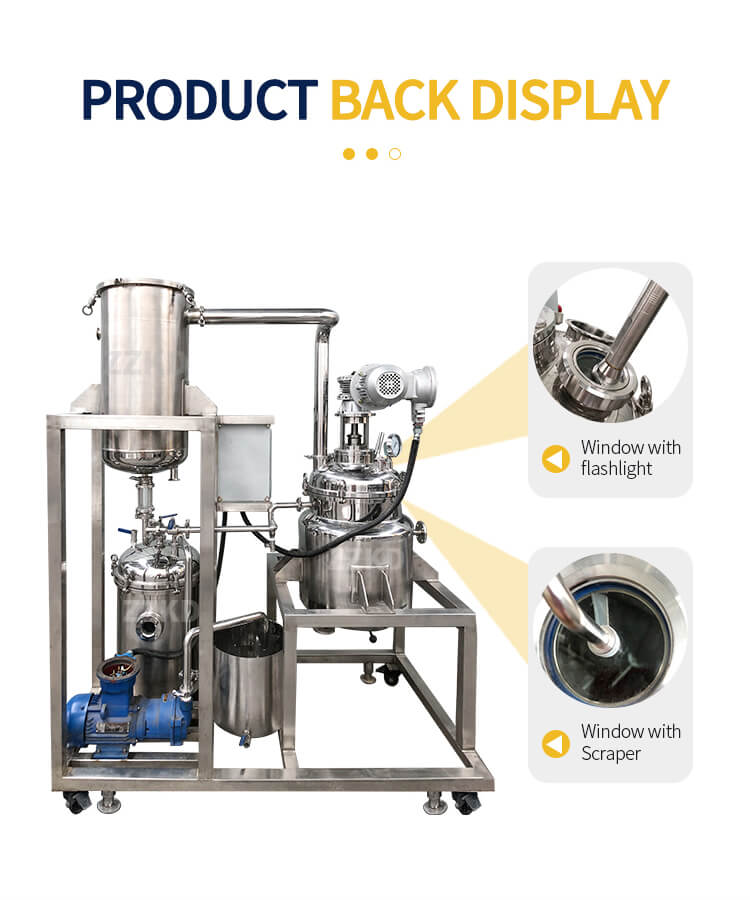- +86 17324835373
- [email protected]
- 19/F, Block B, Guohong Mansion, Zhengzhou, Henan, China
Decarboxylation reactors are chemical reactors specially designed to carry out the decarboxylation process. Decarboxylation is a chemical reaction that involves the removal of carboxyl groups (COOH) from molecules, usually through the application of heat or other forms of energy.
Decarboxylation is commonly used to produce a wide variety of chemicals, including pharmaceuticals, flavors, fragrances and cannabinoids such as THC and CBD. In the case of cannabinoid production, decarboxylation is necessary to convert the inactive form of cannabinoids, such as THCA, into active forms, such as THC, which can then be used for medical or recreational purposes.

Decarboxylation reactors are used in a variety of industries including pharmaceuticals, chemicals, food and materials science. The purpose of crystallization is to produce crystals of the desired size, shape and purity, which can then be further collected and processed as required.
1. High Purity: The decarboxylation reactor can produce crystals of very high purity, making it ideal for applications that require high purity, such as pharmaceuticals, food, and electronics.
2. Precise control: The temperature, pressure and other parameters of the crystallization process can be precisely controlled in the reactor, so as to better control the size, shape and other properties of the crystal.
3. Scalability: The decarboxylation reactor can be easily scaled up or down to accommodate different production volumes, making it suitable for both small laboratory work and large-scale industrial production.
4. Energy Efficiency: By optimizing the crystallization process in the reactor, energy consumption can be reduced and the overall efficiency can be improved, resulting in cost savings and environmental benefits.
5. Reduce labor demand: The decarboxylation reactor can be automated to a large extent, reducing manual intervention and labor costs.
6. Reproducibility: By using a decarboxylation reactor, consistent results can be obtained, which is very important for quality control and process validation.
The advantages of decarboxylation reactors make them a popular choice for producing high-quality crystals in various industries.

1. Drugs: Crystallization is a critical step in drug production because it can help purify and isolate active ingredients and control their release and bioavailability. Decarboxylation reactors are used in the production of a variety of pharmaceutical products including drugs, vitamins and supplements.
2. Chemicals: Decarboxylation reactors are used to produce a wide range of chemicals including fertilizers, polymers and specialty chemicals. Crystallization can be used to purify and separate different components, as well as to control the properties of the final product.
3. Food and Beverage: The food and beverage industry uses crystallization to produce a variety of products including sugar, salt, chocolate and honey. Crystallization can be used to control the texture, appearance and flavor of these products.
4. Materials Science: Decarboxylation reactors are used in materials science to produce high-quality crystals for a variety of applications, including electronics, optics, and energy storage.
5. Mining: The mining industry uses crystallization to extract and purify minerals from ores. Crystallization can be used to separate different minerals and control their properties, making it an important part of mineral processing.
The versatility and effectiveness of decarboxylation reactors make them an invaluable tool in many different industries.

The operation of a decarboxylation reactor may vary depending on the specific design and application of the reactor, but the following are some general steps involved in the operation of a decarboxylation reactor:
1. Preparation: The reactor is cleaned and ready for use, adding necessary components such as solvent and nucleating agent.
2. Heating: Heating a solution or melt to a specific temperature to dissolve the solute.
3. Cooling: The solution or melt is slowly cooled to a specific temperature to promote the formation of crystals. The cooling rate and temperature profile can be carefully controlled to obtain the desired crystal size, shape and purity.
4. Nucleation: Nucleating agents can be added to the solution or melt to facilitate the formation of crystals. Nucleating agents can be added at specific times during cooling to control the size and number of crystals formed.
5. Separation: The crystals are separated from the remaining solution or melt using a filtration or centrifugation process.
6. Drying: The crystals are dried to remove any residual solvent or moisture.
7. Quality Control: The final product is analyzed to ensure it meets the required quality specifications.
In addition to these steps, the operation of the decarboxylation reactor may involve the use of various sensors and monitoring systems to track the progress of the process and make adjustments as needed. Reactors can also be designed to allow the addition of other components, such as stabilizers or modifiers, to control the properties of the final product.

A decarboxylation reactor typically involves heating the solution or melt to dissolve the solute, cooling the solution or melt to promote crystal formation, adding a nucleating agent to promote crystal growth, separating the crystals from the remaining solution or melt, and drying the crystals to remove any remaining solvent or moisture.
Decarboxylation reactors are used in a variety of industries including pharmaceutical, chemical, food and beverage, materials science and mining.
The crystallization process can be affected by factors such as temperature, cooling rate, nucleating agent, stirring rate, solvent composition, and impurities in the solution or melt.
Capacity of kettle body | 50L | 100L |
Motor | 0.75kW | 0.75kW |
Condensation area | 0.75㎡ | 1.1㎡ |
Collection tank | 40L | 75L |
Equipment size (L*W*H) | 1650*860*2000 mm | 1750*970*2100mm |
Circulating water vacuum pump | 1.45kW, 0.87m³/L | |
Electric box | Inverter, switch | |
Heat exchange method | Jacketed circulation, outer 50mm insulation layer | |
Kettle cover | Equipped with vacuum gauge, temperature probe, Liquid inlet, solid inlet, Vacuum port, spare port, sight glass *2 (with light, scraper). The interface size is φ50.5 and the quick-release chuck can also be customized. | |
Jacket import and export | Can be customized according to customer requirements, including outer wire, pagoda mouth, flange, and quick-release chuck. | |
Please leave your contact information, we will arrange the business staff to contact you as soon as we see the message.
Copyright © 2022. ZZKD machinery equipment co., LTD All rights Sitemap